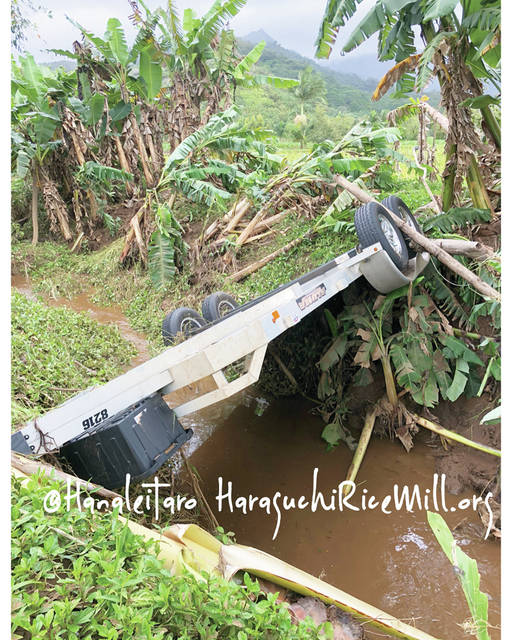HANALEI — The Haraguchi family is used to wading in muddy water, but 2018 brought a whole new level of flooding to the taro lo’i that border the Hanalei River.
They’re iconic of the North Shore town, large patches of green nestled in the shadow of misty mountains and farmed by six generations of the Haraguchi family.
But in April 2018, heavy rains caused the Hanalei River to overflow its banks and all 55 acres of the family farm as well as the historic Rice Mill museum.
Established lo’i and newly planted fields were washed out. Tractors and vehicles were lost. The farmhouse, office, and nonprofit Ho`opulapula Haraguchi Rice Mill agrarian museum were completely flooded. Underneath the farmhouse and office, five foundational pillars were knocked from the foundation. Artifacts and display cases were flipped over and damaged as floodwater pushed through floorboards and walls.
“The height and the velocity of the flash floods were so dangerous, nothing like anything I have seen in my lifetime doing flash flood evacuation on our family farm,” said Lyndsey Haraguchi-Nakayama, who has been working on her family’s farm since she was 6 years old.
She said no one in their family had seen the kind of devastation that tore apart the farm in 2018 — not even her 97 year-old grandfather, who is still doing his part on the farm today.
As the April floodwaters receded, the family shifted into cleanup mode, trying to wash down the mud and silt before it dried out and hardened, and salvaging what they could from flooded buildings and fields. They started planting taro huli (new taro plants) and rebuilding.
But, that wasn’t the end of the flooding for anyone in that valley in 2018.
Remnants of Hurricane Lane in August covered all the fields again and washed away the newly planted taro. Dec. 29 rains triggered flooding that covered their fields for a third time.
And though they’ve been battling floodwaters for more than a year and their recovery efforts have been battered down by the weather more than once, the family is dedicated to restoring their historic structures to pre-April 2018 condition.
“We tried to save all that we could from the house and office and are currently awaiting word that it might be unsavable and might be demolished as floors are collapsing due to foundations on each having been washed out by the floods,” Haraguchi said. “Hanalei lunchwagon was flooded as well as all inventory and all appliances, everything electrical had to be replaced.”
They say it’s going to be a long journey.
“We have been deep in recovery efforts day and night,” Haraguchi said.
The farmhouse and office are still collapsing and will have to be demolished. The museum is still closed and the family is still trying to salvage artifacts that date back to the 1800s — that nonprofit agrarian museum is the last and only historic rice mill left in the state.
The lunch wagon has reopened, with proceeds going toward recovery efforts on the farm.
Before the flood, the family hosted tours of their historic farm and of the rice mill. They’ve sparked the bus back up and are offering tours again, but instead of the regular path, it’s the Taro Farm Flood Recovery EcoTour. They offer more information on the recent floods, and floods in history instead of touring the rice mill.
With five generations behind hers, Haraguchi said the family is dedicated to restoring their homestead and to continuing the mission of educating the community and visitors about the culture of Kauai and the history of their farm.
“No matter what happens we need to keep moving forward,” Haraguchi said. “It will be a long journey,”
••• Jessica Else, environment reporter, can be reached at 245-0452 or at jelse@thegardenisland.com

 Contributed by Haraguchi family
Contributed by Haraguchi family